Tianyi Li
Moon: A Modality Conversion-based Efficient Multivariate Time Series Anomaly Detection
Oct 02, 2025Abstract:Multivariate time series (MTS) anomaly detection identifies abnormal patterns where each timestamp contains multiple variables. Existing MTS anomaly detection methods fall into three categories: reconstruction-based, prediction-based, and classifier-based methods. However, these methods face two key challenges: (1) Unsupervised learning methods, such as reconstruction-based and prediction-based methods, rely on error thresholds, which can lead to inaccuracies; (2) Semi-supervised methods mainly model normal data and often underuse anomaly labels, limiting detection of subtle anomalies;(3) Supervised learning methods, such as classifier-based approaches, often fail to capture local relationships, incur high computational costs, and are constrained by the scarcity of labeled data. To address these limitations, we propose Moon, a supervised modality conversion-based multivariate time series anomaly detection framework. Moon enhances the efficiency and accuracy of anomaly detection while providing detailed anomaly analysis reports. First, Moon introduces a novel multivariate Markov Transition Field (MV-MTF) technique to convert numeric time series data into image representations, capturing relationships across variables and timestamps. Since numeric data retains unique patterns that cannot be fully captured by image conversion alone, Moon employs a Multimodal-CNN to integrate numeric and image data through a feature fusion model with parameter sharing, enhancing training efficiency. Finally, a SHAP-based anomaly explainer identifies key variables contributing to anomalies, improving interpretability. Extensive experiments on six real-world MTS datasets demonstrate that Moon outperforms six state-of-the-art methods by up to 93% in efficiency, 4% in accuracy and, 10.8% in interpretation performance.
Advancing Knowledge Tracing by Exploring Follow-up Performance Trends
Aug 11, 2025


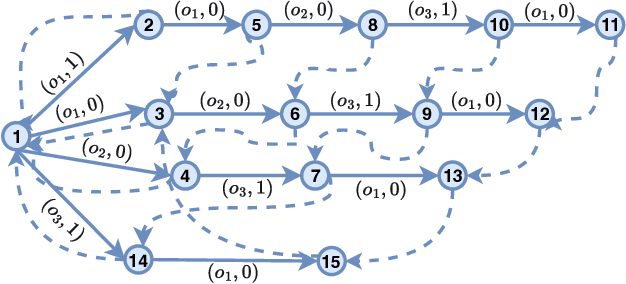
Abstract:Intelligent Tutoring Systems (ITS), such as Massive Open Online Courses, offer new opportunities for human learning. At the core of such systems, knowledge tracing (KT) predicts students' future performance by analyzing their historical learning activities, enabling an accurate evaluation of students' knowledge states over time. We show that existing KT methods often encounter correlation conflicts when analyzing the relationships between historical learning sequences and future performance. To address such conflicts, we propose to extract so-called Follow-up Performance Trends (FPTs) from historical ITS data and to incorporate them into KT. We propose a method called Forward-Looking Knowledge Tracing (FINER) that combines historical learning sequences with FPTs to enhance student performance prediction accuracy. FINER constructs learning patterns that facilitate the retrieval of FPTs from historical ITS data in linear time; FINER includes a novel similarity-aware attention mechanism that aggregates FPTs based on both frequency and contextual similarity; and FINER offers means of combining FPTs and historical learning sequences to enable more accurate prediction of student future performance. Experiments on six real-world datasets show that FINER can outperform ten state-of-the-art KT methods, increasing accuracy by 8.74% to 84.85%.
MH-GIN: Multi-scale Heterogeneous Graph-based Imputation Network for AIS Data (Extended Version)
Jul 27, 2025Abstract:Location-tracking data from the Automatic Identification System, much of which is publicly available, plays a key role in a range of maritime safety and monitoring applications. However, the data suffers from missing values that hamper downstream applications. Imputing the missing values is challenging because the values of different heterogeneous attributes are updated at diverse rates, resulting in the occurrence of multi-scale dependencies among attributes. Existing imputation methods that assume similar update rates across attributes are unable to capture and exploit such dependencies, limiting their imputation accuracy. We propose MH-GIN, a Multi-scale Heterogeneous Graph-based Imputation Network that aims improve imputation accuracy by capturing multi-scale dependencies. Specifically, MH-GIN first extracts multi-scale temporal features for each attribute while preserving their intrinsic heterogeneous characteristics. Then, it constructs a multi-scale heterogeneous graph to explicitly model dependencies between heterogeneous attributes to enable more accurate imputation of missing values through graph propagation. Experimental results on two real-world datasets find that MH-GIN is capable of an average 57% reduction in imputation errors compared to state-of-the-art methods, while maintaining computational efficiency. The source code and implementation details of MH-GIN are publicly available https://github.com/hyLiu1994/MH-GIN.
Test-time Scaling Techniques in Theoretical Physics -- A Comparison of Methods on the TPBench Dataset
Jun 25, 2025Abstract:Large language models (LLMs) have shown strong capabilities in complex reasoning, and test-time scaling techniques can enhance their performance with comparably low cost. Many of these methods have been developed and evaluated on mathematical reasoning benchmarks such as AIME. This paper investigates whether the lessons learned from these benchmarks generalize to the domain of advanced theoretical physics. We evaluate a range of common test-time scaling methods on the TPBench physics dataset and compare their effectiveness with results on AIME. To better leverage the structure of physics problems, we develop a novel, symbolic weak-verifier framework to improve parallel scaling results. Our empirical results demonstrate that this method significantly outperforms existing test-time scaling approaches on TPBench. We also evaluate our method on AIME, confirming its effectiveness in solving advanced mathematical problems. Our findings highlight the power of step-wise symbolic verification for tackling complex scientific problems.
Neutralizing Bias in LLM Reasoning using Entailment Graphs
Mar 14, 2025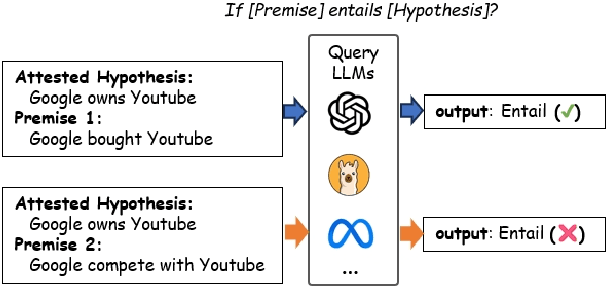


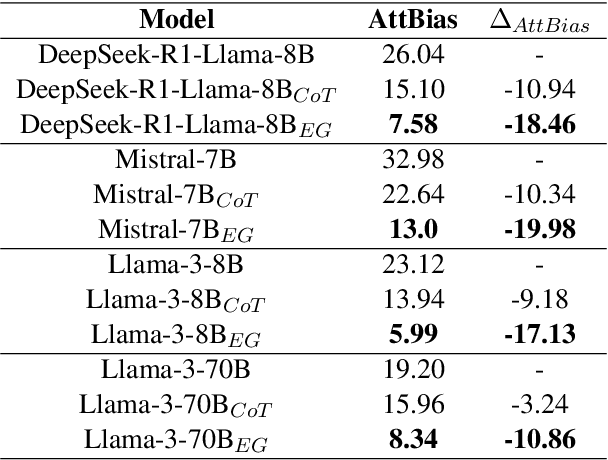
Abstract:LLMs are often claimed to be capable of Natural Language Inference (NLI), which is widely regarded as a cornerstone of more complex forms of reasoning. However, recent works show that LLMs still suffer from hallucinations in NLI due to attestation bias, where LLMs overly rely on propositional memory to build shortcuts. To solve the issue, we design an unsupervised framework to construct counterfactual reasoning data and fine-tune LLMs to reduce attestation bias. To measure bias reduction, we build bias-adversarial variants of NLI datasets with randomly replaced predicates in premises while keeping hypotheses unchanged. Extensive evaluations show that our framework can significantly reduce hallucinations from attestation bias. Then, we further evaluate LLMs fine-tuned with our framework on original NLI datasets and their bias-neutralized versions, where original entities are replaced with randomly sampled ones. Extensive results show that our framework consistently improves inferential performance on both original and bias-neutralized NLI datasets.
Advancing vision-language models in front-end development via data synthesis
Mar 03, 2025Abstract:Modern front-end (FE) development, especially when leveraging the unique features of frameworks like React and Vue, presents distinctive challenges. These include managing modular architectures, ensuring synchronization between data and visual outputs for declarative rendering, and adapting reusable components to various scenarios. Such complexities make it particularly difficult for state-of-the-art large vision-language models (VLMs) to generate accurate and functional code directly from design images. To address these challenges, we propose a reflective agentic workflow that synthesizes high-quality image-text data to capture the diverse characteristics of FE development. This workflow automates the extraction of self-contained\footnote{A \textbf{self-contained} code snippet is one that encapsulates all necessary logic, styling, and dependencies, ensuring it functions independently without requiring external imports or context.} code snippets from real-world projects, renders the corresponding visual outputs, and generates detailed descriptions that link design elements to functional code. To further expand the scope and utility of the synthesis, we introduce three data synthesis strategies: Evolution-based synthesis, which enables scalable and diverse dataset expansion; Waterfall-Model-based synthesis, which generates logically coherent code derived from system requirements; and Additive Development synthesis, which iteratively increases the complexity of human-authored components. We build a large vision-language model, Flame, trained on the synthesized datasets and demonstrate its effectiveness in generating React code via the $\text{pass}@k$ metric. Our results suggest that a code VLM trained to interpret images before code generation may achieve better performance.
Theoretical Physics Benchmark (TPBench) -- a Dataset and Study of AI Reasoning Capabilities in Theoretical Physics
Feb 19, 2025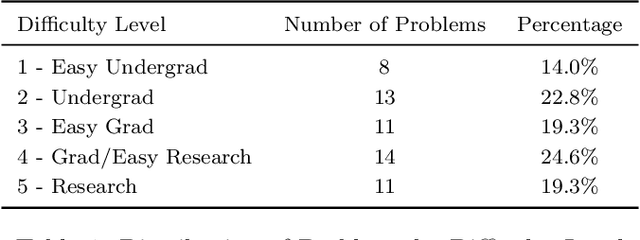
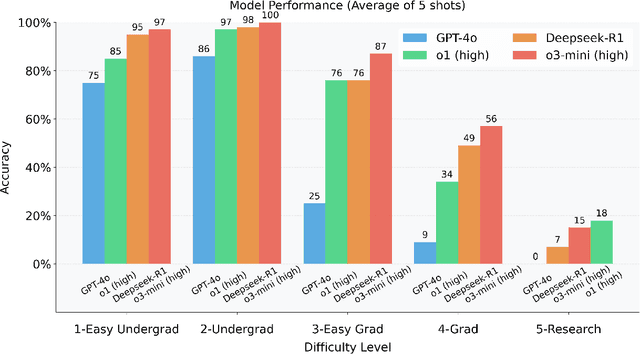

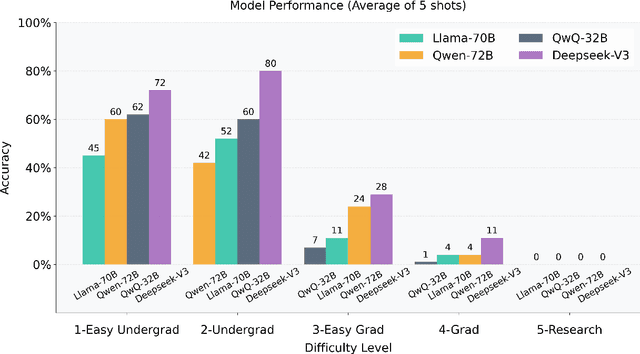
Abstract:We introduce a benchmark to evaluate the capability of AI to solve problems in theoretical physics, focusing on high-energy theory and cosmology. The first iteration of our benchmark consists of 57 problems of varying difficulty, from undergraduate to research level. These problems are novel in the sense that they do not come from public problem collections. We evaluate our data set on various open and closed language models, including o3-mini, o1, DeepSeek-R1, GPT-4o and versions of Llama and Qwen. While we find impressive progress in model performance with the most recent models, our research-level difficulty problems are mostly unsolved. We address challenges of auto-verifiability and grading, and discuss common failure modes. While currently state-of-the art models are still of limited use for researchers, our results show that AI assisted theoretical physics research may become possible in the near future. We discuss the main obstacles towards this goal and possible strategies to overcome them. The public problems and solutions, results for various models, and updates to the data set and score distribution, are available on the website of the dataset tpbench.org.
Open-Sora: Democratizing Efficient Video Production for All
Dec 29, 2024

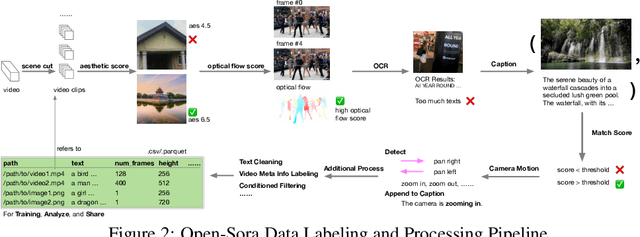
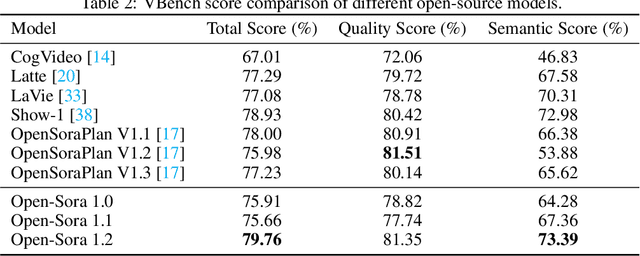
Abstract:Vision and language are the two foundational senses for humans, and they build up our cognitive ability and intelligence. While significant breakthroughs have been made in AI language ability, artificial visual intelligence, especially the ability to generate and simulate the world we see, is far lagging behind. To facilitate the development and accessibility of artificial visual intelligence, we created Open-Sora, an open-source video generation model designed to produce high-fidelity video content. Open-Sora supports a wide spectrum of visual generation tasks, including text-to-image generation, text-to-video generation, and image-to-video generation. The model leverages advanced deep learning architectures and training/inference techniques to enable flexible video synthesis, which could generate video content of up to 15 seconds, up to 720p resolution, and arbitrary aspect ratios. Specifically, we introduce Spatial-Temporal Diffusion Transformer (STDiT), an efficient diffusion framework for videos that decouples spatial and temporal attention. We also introduce a highly compressive 3D autoencoder to make representations compact and further accelerate training with an ad hoc training strategy. Through this initiative, we aim to foster innovation, creativity, and inclusivity within the community of AI content creation. By embracing the open-source principle, Open-Sora democratizes full access to all the training/inference/data preparation codes as well as model weights. All resources are publicly available at: https://github.com/hpcaitech/Open-Sora.
HalluCana: Fixing LLM Hallucination with A Canary Lookahead
Dec 10, 2024Abstract:In this paper, we present HalluCana, a canary lookahead to detect and correct factuality hallucinations of Large Language Models (LLMs) in long-form generation. HalluCana detects and intervenes as soon as traces of hallucination emerge, during and even before generation. To support timely detection, we exploit the internal factuality representation in the LLM hidden space, where we investigate various proxies to the LLMs' factuality self-assessment, and discuss its relation to the models' context familiarity from their pre-training. On biography generation, our method improves generation quality by up to 2.5x, while consuming over 6 times less compute.
Digital Twin-Empowered Voltage Control for Power Systems
Dec 09, 2024


Abstract:Emerging digital twin technology has the potential to revolutionize voltage control in power systems. However, the state-of-the-art digital twin method suffers from low computational and sampling efficiency, which hinders its applications. To address this issue, we propose a Gumbel-Consistency Digital Twin (GC-DT) method that enhances voltage control with improved computational and sampling efficiency. First, the proposed method incorporates a Gumbel-based strategy improvement that leverages the Gumbel-top trick to enhance non-repetitive sampling actions and reduce the reliance on Monte Carlo Tree Search simulations, thereby improving computational efficiency. Second, a consistency loss function aligns predicted hidden states with actual hidden states in the latent space, which increases both prediction accuracy and sampling efficiency. Experiments on IEEE 123-bus, 34-bus, and 13-bus systems demonstrate that the proposed GC-DT outperforms the state-of-the-art DT method in both computational and sampling efficiency.
 Add to Chrome
Add to Chrome Add to Firefox
Add to Firefox Add to Edge
Add to Edge